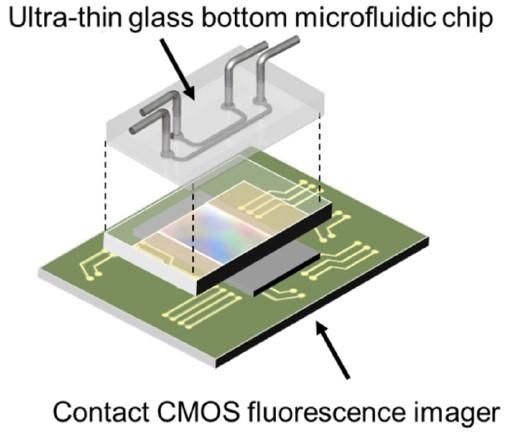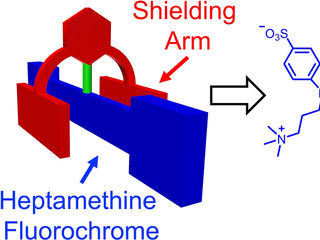Fluorescence microscopy on a chip -- no lenses required
fluorescence microscopy gives researchers incredible power to illuminate the tiniest structures and capture the real-time activities of live cells by tagging biological molecules with a veritable rainbow of fluorescent dyes. This power comes at a cost: The technology can be expensive and time-consuming and, so far, has resisted attempts at automation.

A diagram of the on-chip fluorescence imaging platform showing how the ultra-thin glass bottom microfluidic chip sits on top of the contact CMOS fluorescence imager.
Takehara et al.
This situation may be changing however, with the introduction of microfluid chip-based platforms. One such newly developed platform has been developed by a team of Japanese researchers. Their system enables scientists to rapidly image fluorescent cells grown inside the chip using a CMOS image sensor, the same technology found in the camera of a smartphone. The new system has numerous potential uses in biomedical research.
"Conventional tabletop-type optical microscopes are powerful tools for researchers, but they are not truly adequate for fully automated systems because of the expense and the necessity of well-trained technicians," said Hiroaki Takehara, who researches automated cell processing devices at the University of Tokyo and is one of the study's authors.
To develop an on-chip system, he teamed up with co-author Jun Ohta of the Nara Institute of Science and Technology, an expert in CMOS image sensor technology.
Other groups have developed chip-based fluorescent microscopy systems previously, but those setups required the sample to sit directly on the image sensor chip, which introduces the risk of cross-contamination. These systems cannot be truly high-throughput because the sensor chips must be washed in between use.
Takehara and colleagues developed disposable chips to overcome these limitations. The chip contains microfluidic channels specially designed for culturing cells and the introduction of culture media, drugs and other biological molecules. The chip has an ultra-thin glass bottom that minimizes the distance between the cells and the contact sensor below. A CMOS image sensor detects the fluorescence emitted by the cells, turns it into an electronic signal and then reconstructs the image.
To demonstrate the effectiveness of their system, the researchers grew cells containing fluorescent dyes in their nuclei within the microchannels. When they exposed cells to endothelial growth factor (EGF), which causes cell proliferation, the cultures gave off a more intense fluorescence signal than cultures that were not treated with EGF, indicating that the sensor detected cell growth.
The authors acknowledge that the on-chip fluorescence microscopy platform yields images with poorer spatial resolution than those of conventional fluorescence microscopes, but offers the advantage of being compatible with fully automated systems. The platform's small size and affordability also make it attractive for use in implantable devices for measuring glucose or even brain activity.
In future work, Takehara plans to explore the use of the platform for monitoring stem cell production for use in regenerative medicine and for screening new drugs.
"The excessive cost of developing novel pharmaceutical drugs and the urgent requirement for [affordable] screening technology has become a pressing issue," Takehara said. "A fully automated system, from sample handling to detection, without the necessity of well-trained technicians is a key technology, and serves a pivotal role in the development of cell-based cost-effective screening."
Original publication
Most read news
Original publication
Hiroaki Takehara and Osawa Kazutaka and Makito Haruta and Toshihiko Noda and Kiyotaka Sasagawa and Takashi Tokuda and Jun Ohta; "On-chip cell analysis platform: Implementation of contact fluorescence microscopy in microfluidic chips"; AIP Advances; 2017
Topics
Organizations
Other news from the department science
These products might interest you

Software & Data Management by Carl Zeiss
Bring Context to your Data with ZEISS Connected Microscopy
Your solution for microscopy, analysis and data management

HYPERION II by Bruker
FT-IR and IR laser imaging (QCL) microscope for research and development
Analyze macroscopic samples with microscopic resolution (5 µm) in seconds

Get the analytics and lab tech industry in your inbox
By submitting this form you agree that LUMITOS AG will send you the newsletter(s) selected above by email. Your data will not be passed on to third parties. Your data will be stored and processed in accordance with our data protection regulations. LUMITOS may contact you by email for the purpose of advertising or market and opinion surveys. You can revoke your consent at any time without giving reasons to LUMITOS AG, Ernst-Augustin-Str. 2, 12489 Berlin, Germany or by e-mail at revoke@lumitos.com with effect for the future. In addition, each email contains a link to unsubscribe from the corresponding newsletter.
Most read news
More news from our other portals
See the theme worlds for related content
Topic World Cell Analysis
Cell analyse advanced method allows us to explore and understand cells in their many facets. From single cell analysis to flow cytometry and imaging technology, cell analysis provides us with valuable insights into the structure, function and interaction of cells. Whether in medicine, biological research or pharmacology, cell analysis is revolutionizing our understanding of disease, development and treatment options.

Topic World Cell Analysis
Cell analyse advanced method allows us to explore and understand cells in their many facets. From single cell analysis to flow cytometry and imaging technology, cell analysis provides us with valuable insights into the structure, function and interaction of cells. Whether in medicine, biological research or pharmacology, cell analysis is revolutionizing our understanding of disease, development and treatment options.
Topic world Fluorescence microscopy
Fluorescence microscopy has revolutionized life sciences, biotechnology and pharmaceuticals. With its ability to visualize specific molecules and structures in cells and tissues through fluorescent markers, it offers unique insights at the molecular and cellular level. With its high sensitivity and resolution, fluorescence microscopy facilitates the understanding of complex biological processes and drives innovation in therapy and diagnostics.

Topic world Fluorescence microscopy
Fluorescence microscopy has revolutionized life sciences, biotechnology and pharmaceuticals. With its ability to visualize specific molecules and structures in cells and tissues through fluorescent markers, it offers unique insights at the molecular and cellular level. With its high sensitivity and resolution, fluorescence microscopy facilitates the understanding of complex biological processes and drives innovation in therapy and diagnostics.

























































